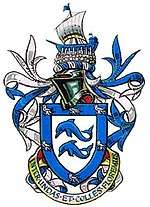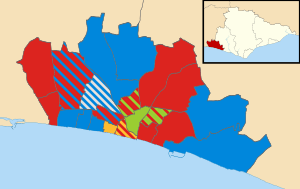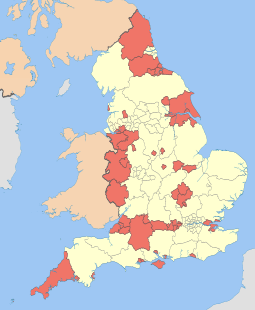Brighton and Hove City Council
| Brighton and Hove City Council | |
|---|---|
 Coat of arms | |
 Corporate Logo | |
| Type | |
| Type | |
| History | |
| Founded | 1 April 1997 |
| Preceded by |
East Sussex County Council District councils
|
| Leadership | |
Mayor |
Cllr Mo Marsh Since 18 May 2017 |
Leader of the council | |
Leader of the opposition |
Cllr Geoffrey Theobald, Conservative |
Convenor of the Green Group |
Cllr Phelim MacCafferty, Green |
Chief Executive |
Geoffrey Raw |
| Structure | |
| Seats | 54 councillors |
 | |
Political groups |
|
Joint committees | Greater Brighton City Board |
Length of term | 4 years |
| Elections | |
| First past the post, multi-member | |
Last election | 7 May 2015 |
Next election | 2 May 2019 |
| Meeting place | |
|
Brighton Town Hall Hove Town Hall | |
| Website | |
|
www | |
Brighton and Hove City Council is the local authority of the city of Brighton and Hove. It is a unitary authority, having the powers of a non-metropolitan county and district council combined. It provides a full range of local government services including Council Tax billing, libraries, social services, processing planning applications, waste collection and disposal, and it is a local education authority.
Powers and functions
The local authority derives its powers and functions from the Local Government Act 1972 and subsequent legislation. For the purposes of local government, Brighton and Hove is within a non-metropolitan area of England. As a unitary authority, Brighton and Hove City Council has the powers and functions of both a non-metropolitan county and district council combined. In its capacity as a district council it is a billing authority collecting Council Tax and business rates, it processes local planning applications, it is responsible for housing, waste collection and environmental health. In its capacity as a county council it is a local education authority, responsible for social services, libraries and waste disposal.
Political control
Since the first election to the council in 1996 political control of the council has been held by the following parties:[1]
| Party in control | Party in minority lead | ||||
|---|---|---|---|---|---|
| Labour | 1996–2003 | ||||
| No overall control | 2003–present | Labour | 2003–2007 | ||
| Conservative | 2007–2011 | ||||
| Green | 2011–2015 | ||||
| Labour | 2015–present | ||||
The Green led council from 2011-2015 was the first of its kind in the United Kingdom.[2]
Wards
When Brighton Borough Council and Hove Borough Council merged in 1996 the wards were carried over from the respective councils who had both been under East Sussex County Council.
There were originally 26 Wards each with three councillors totally 78 councillors in the newly created Brighton and Hove Borough Council: Brunswick and Adelaide, Goldsmid, Hangleton, Hanover, Hollingbury, Kings Cliff, Marine, Moulsecoomb, Nevill, North Portslade, Patcham, Portslade South, Preston, Queens Park, Regency, Rottingdean, Seven Dials, St. Peters, Stanford, Stanmer, Tenantry, Vallance, Westbourne, Westdene, Wish, Woodingdean
.png)
The 2001 boundary review [3][4][5] reduced the wards to 21 Wards with a mix of two or three councillors each totalling 54 councillors for the then city council. These boundary were used in the 2003 election for the first time with the following wards: Brunswick and Adelaide, Central Hove, East Brighton, Goldsmid, Hangleton and Knoll, Hanover and Elm Grove, Hollingbury and Stanmer (which then became Hollingdean and Stanmer in 2007), Stanford (which became Hove Park in 2007), Moulsecoomb and Bevendean, North Portslade, Patcham, Preston Park, Queen's Park, Regency, Rottingdean Coastal, South Portslade, St Peter's and North Laine, Westbourne, Wish, Withdean, Woodingdean.
Future structure
In October 2017, it was announced that the city council was to merge with Brighton and Hove Clinical Commissioning Group to form a Health and Social Care Integration Board: the merge, commencing in April 2018 and culminating in a full merger a year later, is intended to prevent the duplication of work and streamline provision of health and social care within the city.[6]

References
- ↑ "Brighton & Hove". BBC News Online. Retrieved 8 October 2009.
- ↑ "Go Green for first Green-led council in UK". www.greenparty.org.uk. Retrieved 2016-12-20.
- ↑ legislation.gov.uk - The City of Brighton and Hove (Electoral Changes) Order 2001. Retrieved on 4 October 2015.
- ↑ "Your Local Councillors". Brighton & Hove City Council. Archived from the original on 30 January 2009. Retrieved 8 October 2009.
- ↑ "Councillors & Meetings". Brighton & Hove City Council. Archived from the original on 25 August 2009. Retrieved 8 October 2009.
- ↑ le Duc, Frank (12 October 2017). "Brighton and Hove council to merge with NHS commissioning body". Brighton and Hove News.
